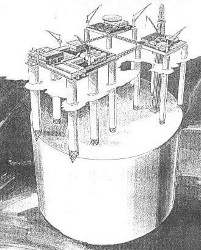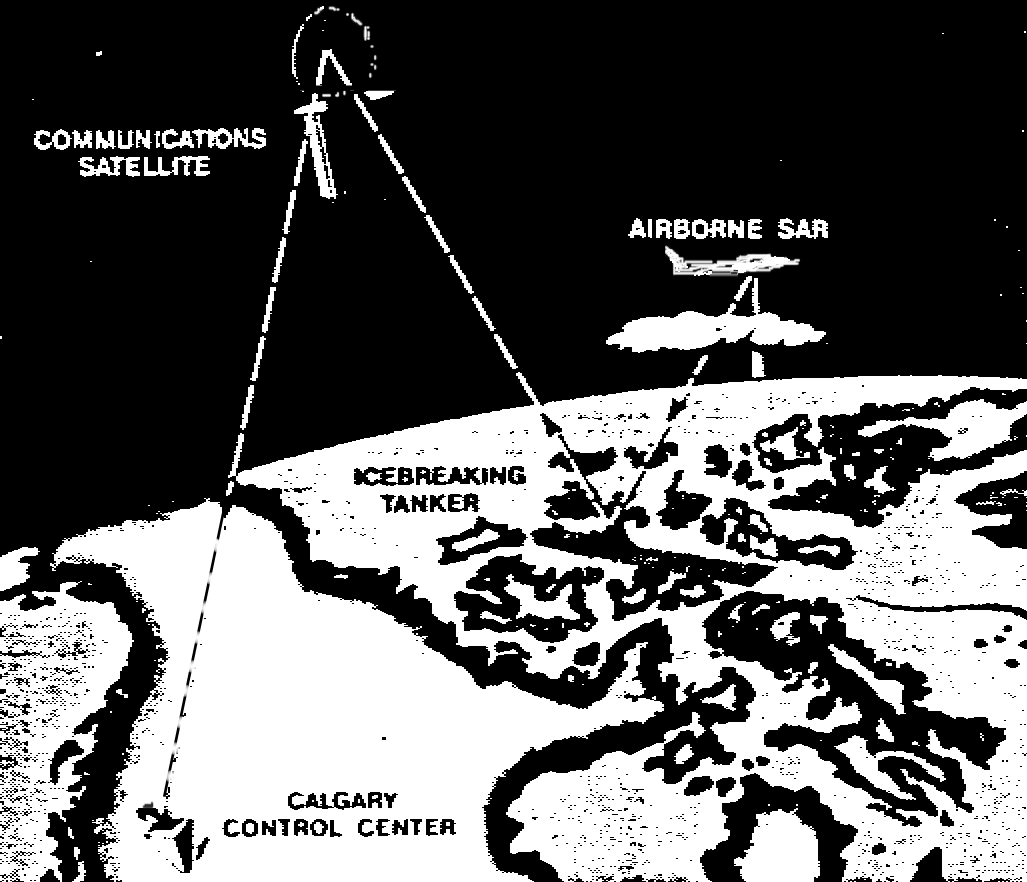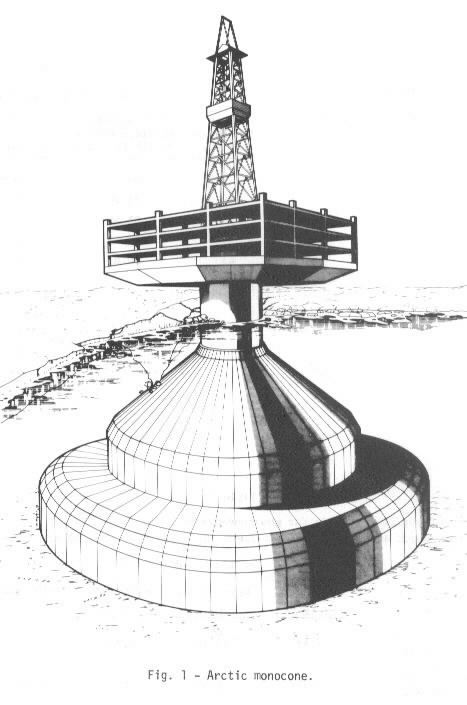|








Quick Links
Listings: 1997-Present
Listings: 1996 & Earlier
Abstracts:
1997-Present
Abstracts: 1996 & Earlier
|
|
94.05 |
Evolution of Arctic Marine
Structural Forms
(OTC Paper 7461)
Presented at the
26th Annual Offshore Technology Conference (OTC)
Houston, TX, USA, 2-5
May 1994
Author: Frank G. Bercha
Over the last quarter
century, the evolution of structural forms for offshore
structures in the North American Arctic has been closely tied to
developments in our understanding of ice structure interactions.
The architecture of offshore structures is one of pure function:
to support an operation and to survive. Once the socio-economic
and environmental issues are resolved, islands, bottom founded
structures, floating structures, and active devices, the
principal categories, derive their form almost exclusively from
the designer’s understanding of the ice, environmental, and
operational forces to which they are expected to be subjected.
The evolution of their forms reflects development of ice
mechanical knowledge. Islands were initially designed as simple
gravel mounds with a flat top, and have evolved to incorporate
slope protection, freezing, ice barriers, and for deeper water
caisson containment walls. The gravity based structure has taken
a multitude of forms on the drawing board, resulting in several
different realizations including the Concrete Island Drilling
System (CIDS) and the Single Steel Drilling Caisson (SSDC).
Monopods, monocones, the Hibernia star structure, and various
storage and platform combinations are designed to passively
resist the full spectrum of ice forces to which they are likely
to be subjected. Active structures, which in some way actively
destroy or avoid ice features capable of causing damage to them,
have led to fantastic and sometimes bizarre designs. Floating
structures, a more conventional variation of active structures,
include ice vaning ships, the round Kulluk and various forms of
stationary icebreakers. The paper follows the evolution of the
forms in each of the principal classes within the context of
associated ice mechanical developments. Possible evolutionary
directions for the future are considered, including use of new
materials and technologies such as space alloys, composite
construction, and underwater habitats. The designs, prototypes,
and structures presented in the paper are based on those
developed in the industry.
TOP= |
|
90.01 |
Icecrete - An Ice-Based
Construction Material
Presented at the
CSME Mechanical Engineering Forum, Ice Mechanics Symposium
Toronto, Canada, 1990
Authors: Frank G. Bercha,
President, and T.G. Brown, Associate, Bercha Group / P. Hofseth,
Project Engineer, and P. Olsen, President, ICECRETE Contracting
& Engineering, A.S., Oslo, Norway

The paper describes the historical development of a particular
form of reinforced ice, its properties, and potential uses. The
possibility of using ice reinforced with some form of fibrous
material has been considered since the Second World War. While
most attempts have been fraught with difficulties regarding the
composite materials construction, a Norwegian development,
called ICECRETE, has partly solved these problems. The composite
material exhibits mechanical properties which are considerably
better than those of pure ice, particularly the tensile
mechanical properties.
The potential uses of the material are discussed and include
offshore exploration and production structures, at shore
structures, and onshore structures. The general methods of
construction and the operational cooling necessary to maintain
the structure’s integrity during summer months in high Arctic
latitudes are discussed. Finally, certain conclusions regarding
the properties and utilization of ICECRETE are discussed.
TOP= |
|
90.07 |
Optimal High Latitude Radar
Surveillance
Presented at the 1st
CircumpolarRemote Sensing Conference
Yellowknife, NWT, Canada, May
1990
Author: Frank G. Bercha and Jim
W. Steen / Bercha Group
Northern shipping and offshore operations have created a demand
for tactical ice surveillance best carried out using
side-looking airborne radars. The need to provide timely ice or
iceberg information was most tragically and emphatically
illustrated with the Titanic disaster. Since then, northern
shipping lanes have begun to be routinely patrolled by
observation aircraft. With the availability of side-looking
radar, an instrument capable of imaging sea, ice, or iceberg
features regardless of atmospheric, visibility, or illumination
conditions, the use of such radars has been favoured for ice
surveillance. The side-looking radar is a device which emits a
systematic spatial and temporal pattern of microwave pulses
which travel to the target area through cloud cover or darkness
and are reflected from the target and recorded in real time to
produce a radar image such as that illustrated in Figure 1 of
the paper. In supporting operational arenas, the recorded data
are generally processed both digitally and analogously, and the
digital data is often electronically transmitted directly from
the aircraft to remote ground stations. The configurations for
appropriate radar systems, data processing capabilities,
platforms, and methods of transmitting information to user
stations at ground or sea level, however, must be selected
through a systematic optimization process based on a systems
approach.

From a practical point of view, the commercial radar industrial
sector is largely centred in Canada. In the mid l970s, the
Atmospheric Environment Services Branch of the Canadian
Government experimented with side-looking airborne radars and in
the late 1970s obtained a Motorola APS 94D to be deployed on ice
patrols on a routine basis. In 1979, the Bercha Group, in
response to requirements by oil companies exploring in Arctic
waters, purchased an APS 94D system mounted in a Gulf Stream
G159 aircraft, thus being the first Canadian commercial company
to own and operate an airborne radar. This organization
continues today to own and operate an airborne radar system in
support of high latitude radar surveys as well as providing
services using CCRS’ dual band advanced synthetic aperture
radars. Subsequently, in the early 1980s, another Canadian
company called Intera Technologies acquired a synthetic aperture
radar which was initially deployed for ice patrols and
subsequently for a combination of radar resource mapping
assignments. More recently, this company was instrumental in the
development of an advanced synthetic aperture radar to be
mounted in a Challenger aircraft on contract to the Atmospheric
Environment Services for a dedicated Arctic ice patrol service.
In the mid to late 1980s, further real aperture radars were
developed by Canadian Astronautics Limited and deployed on
contract in Atmospheric Environment Services aircraft. From this
arsenal of radars, and the associated communication, recording,
and other peripheral equipment, it is often necessary to
optimize a given patrol configuration using the principles of
system design and optimization outlined in this paper.
Accordingly, following this brief introduction, Section B
describes the optimization concepts applied to surveillance,
Section C discusses the principal subsystems of an ice
surveillance system, while Section D describes a specific ice
surveillance system which has been subjected to optimal design.
The final section gives some conclusions and recommendations.
TOP= |
|
1985a
(85-04)
|
Monte Carlo Simulation of Arctic
Offshore Drilling Operations
Presented at the Arctic
Offshore Technology Conference and Exposition
Anchorage, Alaska, 3-5 September
1985
Authors: Frank G. Bercha and Thomas G.
Brown, Bercha Group
Accurate prediction of the distribution and cumulative value of
downtime cost-intensive operations such as offshore drilling in
arctic waters is often the key to determining the economic
feasibility of such operations. Downtime, or inability to
operate, can be a result of ice and iceberg action, weather
action, or some other operational problems. Although the total
risk may be determined conventional risk analytic techniques
such as fault trees and decision trees, a good understanding of
its distribution, particularly for complex-environment operation
interactions such as exist in ice-infested waters in the U.S.
and Canadian arctic, off the west coast of Alaska, and off the
east coast of Canada, can best be understood through the
utilization of simulation techniques. In the present paper,
following a brief description of the basics of Monte Carlo
simulation, two case studies carried out by the authors are
reported. The first involves simulation of the interaction of a
wharf-moored drilling platform in the south Beaufort Sea with
ice cover and the associated ice management program interaction
with the environmental conditions; the second describes the
simulation of the interaction of floating drilling operations
with all environmental and operational elements, including a
detailed simulation of the drilling of specific wells. Each case
study is documented through a description of the simulation
process, simulated structure, and presentation of representative
results. Conclusions and recommendations pertaining to the
general applicability of Monte Carlo simulation techniques to
the evaluation of feasibility of drilling operations are
subsequently presented.
TOP= |
|
1984a
(84-07)
|
The Reliability of Ice-Structure
Interaction Load Predictions
Presented at IAHR Ice
Symposium
Hamburg, West Germany, August
1984
Authors: Frank G. Bercha,
President, Bercha Group / R.H. Nagel, Engineering
Associate, Amoco Production Company, USA /
T.G. Brown, Senior Engineer, Bercha Group
The paper describes a method for evaluating the reliability of
ice-structure interaction load predictions for different
interaction modes, structure types, and ice kinematic and
mechanical property cases. Specifically, following the
derivation of reliability measures which take into consideration
the variability of input kinematic and mechanical properties,
accuracy of methodology, and reliability of inherent
ice-structure interaction assumptions, several reliability case
studies are described. These include various combinations of
conical, cylindrical, and multi-pod structures interacting with
first and multi-year ice sheets, ridges, and their combinations.
The work described is based on applications of statistical
methods to ice property evaluation as well as techniques of risk
and reliability analysis applied to the ice-structure
interaction equations and the assumptions upon which they are
based. It is believed that a broad reliability evaluation of the
type described in this paper has heretofore not been developed
and applied, and thus the work described constitutes a novel and
useful contribution to the field of Arctic marine and inland ice
engineering.
TOP= |
|
1984b
(84-06)
|
The State of Art of Statistical
Approaches to Ice Mechanics
Invited Paper, IAHR Ice
Symposium
Hamburg, West Germany, August
1984
Author: Frank G. Bercha /
Bercha Group,
Not available at this time.
TOP= |
|
1983b
(83-06)
|
Evaluation of Pile-Up Formation and
Structure Interaction Forces
(OTC Paper 4462)
Presented at the 15th Annual
Offshore Technology Conference (OTC)
Houston, Texas, USA, 2-5 May 1983
Authors: M.J. Hommel and F.G. Bercha, Bercha Group
Ice pile-ups or rubble fields may form due to the interaction of
Arctic offshore structures with sheet and ridge ice formations.
Interaction parameters favoring the formation of pile-ups
include sufficient driving force to fragment ice formations,
adequate generalized flexibility to permit the necessary
movements, and sufficiently large structural breadth to preclude
clearing of ice fragments. The creation of pile-ups around
offshore structures can have a significant influence on
associated ice-structure interaction forces. This influence can
be one of force magnification or reduction, depending on certain
ice pile-up and interaction characteristics.
.gif)
The ability to predict ice pile-up loading and load transfer
characteristics will facilitate design of Arctic artificial
islands, platforms, jetties, and other large structures with the
potential to generate pile-ups under appropriate ice-structure
interaction conditions.
In this paper, following a general review of the basic concepts
published by the authors and others in the area of rubble pile
formation and force transmittal, extensions of the theory are
presented and results are compared with previously published
work. The extensions include the incorporation of heretofore
unpublished probability density functions to represent slope
angles of individual ice pieces idealized through the use of
multi-modal failure theory.
A significant dependence of interaction load on the properties
of the probability density function is found. In addition, the
effect of pile-ups on ice-structure interaction loads is
evaluated utilizing techniques based on the theories of granular
and cohesive media to evaluate ice pile-up load capacities and
load transfer characteristics. Numerical results are generated
and compared with relevant related theories.
TOP= |
|
1980b
(80-03)
|
The Development and Application
of Multimodal Failure Theory
Invited Paper, the IUTAM
Symposium on the Physics and Mechanics of Ice
Copenhagen, Denmark, 6-10 August
1979
Author: F.G. Bercha
Multimodal ice failure behavior is important for accurate
characterization of numerous ice mechanics phenomena. Ridge
formation, pile-ups, and the associated macroscale ice cover
properties as well as interactions of ice formations with
structures under conditions potentially admitting more than one
failure mode require multimodal characterization. In this paper,
theoretical approaches with associated results for
quantification of multimodal behavior are presented. Simplified
approaches applicable directly by designers are outlined and
corroborated with a more rigorous probabilistic approach.
TOP= |
|
1979a
(79-01)
|
Arctic Offshore Deepwater Ice
Structure Interactions
(OTC Paper 3632)
Presented at 11th Annual Offshore Technology Conference (OTC)
Houston, Texas, USA, 30 April
to 03 May 1979
Authors: F.G. Bercha, Bercha Group
and D.G. Stenning, Dome Petroleum Ltd.

A comprehensive theoretical analysis of deep-water Arctic
ice-structure interactions was partially described in this
paper. Following identification of a severity hierarchy of ice
formations and associated strengths for the 200 ft. water depth
range in the South Beaufort Sea, quasi-static and dynamic
interactions of these formations with a steel monocone
production platform structure were analyzed. The ice formations
identified included sheets, ridges, and ice islands.
Quasi-static analysis of sheet ridge composites impinging
against the structure included development of certain new
failure and clearing mechanisms. Dynamic analysis of
island-structure collisions was approached utilizing energy
balance principles. Probabilistic design theory was applied to
the determination of result statistical bounds consistent with
severity ratings of input variables. Numerical results for
representative quasi-static and dynamic cases were presented and
discussed. Certain non-governing interactive modes, including
pile-up and in-plane ridge flexure, were also discussed briefly.
Conclusions and recommendations for further work were presented.
TOP= |
|
1977c
(77-01)
|
On the Scale Effect in Ice Mechanics
Presented at the 6th Canadian Congress of Applied
Mechanics
Vancouver, BC, Canada, 29 May
to 03 June 1977
Author: Frank G. Bercha
The prediction of forces generated in ice-structure interactions
requires deterministic or probabilistic knowledge of the
effective unit mechanical properties of ice. Although small
sample unit properties of ice have been relatively well
documented (Assur, A., 1972; Bercha, F.G., 1975; Croasdale, K.R.,
1974) the solutions of important practical problems of
large-scale ice-structure interactions are still seriously
hampered by the lack of an adequate means of relating small and
full-scale ice unit properties. This problem of relating
effective full-scale mechanical properties to small sample or
index properties is termed scale effect. It has not been
adequately solved to date.
In this paper, following a review of previous approaches to the
scale effect problem, a definition of the problem is given, and
a comprehensive approach to it, illustrated by recent work done
by time author, is suggested.
TOP= |
|
1975c
(75-03) |
Sprung Structures - Present and
Future
Bulletin of the International
Association for Shell and Spatial Structures, No. 65
Madrid, Spain
Authors: Frank G. Bercha and
Phillip D. Sprung
The Sprung structure is a structurally supported membrane space
enclosure system, consisting of a series of aluminum arches
joined with a composite fabric. It is currently mass
manufactured in clear spans ranging from 20 to 120 feet, of any
required length but larger spans or special forms of the
structure may be produced upon special order. Following a
description of the current form of the structures, details and
results of investigations of the strength and fulfillment of
National Building Code Standards are presented. Subsequently,
current research and development programs and future vistas for
the structural system are considered.
TOP= |
|
1974b
(74-01)
|
New Solid Mechanics Applications in
the Arctic
Presented at
the 2nd Symposium on Applications of Solid Mechanics, Sponsored by CSME, CSCE, ASME
McMaster University, Hamilton,
Ontario, Canada, 17-18 June 1974
Authors Frank G. Bercha
Numerous new solid mechanics problems arise from current
industrial interest and activity in the Arctic. In this paper, a
review of the major mechanics problems related to each of five
main arctic facility application categories is made. These five
categories are: offshore structures, northern enclosures,
submarine facilities, ice structures, and transportation
facilities. Generally, the treatment corresponding to each
category consists of a review of specific facility types,
identification of the problems, reference to relevant work
completed or in progress, and indication of additional work
necessary to solve the problems. It is concluded that the most
pressing and significant solid mechanics problems identifiable
at this time relate to ice, permafrost, and arctic structural
mechanics. However, because of the embryonic level of
development of arctic technology today, investigators are
certain to encounter novel and unexpected problems which can be
solved only with innovative approaches.
TOP= |
|


.gif)
